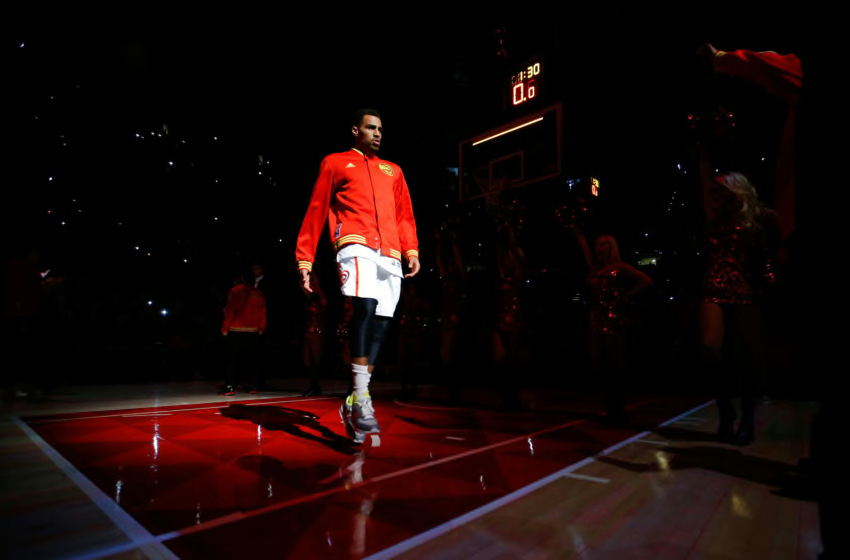
Thabo Sefolosha, #25, Atlanta Hawks, (Photo by Kevin C. Cox/Getty Images)
The Whiteboard is The Step Back’s daily basketball newsletter, covering the NBA, WNBA and more. Subscribe here to get it delivered to you via email each morning.
The news this morning is consumed with reports about chaotic protests in Minneapolis and around the country, a cry for justice after the killing of George Floyd by a Minneapolis police officer last weekend. NBA players have already spoken out, sharing their anger, sadness and frustration.
I don’t want to take this space too far from the bounds of basketball but I will point out that what’s happening now — with the Floyd protests, and the Eric Garner protests before that, and the Michael Brown protests before that, and the Trayvon Martin protests before that … — is not related to the NBA in some abstract way. It’s not about the vague way that distant events impact the emotional lives of NBA players. These events are products of a system that directly and viscerally impacts the lives of NBA players, their physical safety and basic humanity.
In the last few years, NBA players have repeatedly been subjected to racial profiling, violence and abuse, often at the hands of police.
In 2019, Ben Simmons was refused entry to the Crown Casino in Melbourne. The casino said it was because he was suspected of being underage. Simmons says it was because he and his friends are black.
In 2019, the Utah Jazz banned a fan from their arena after a verbal confrontation with Russell Westbrook. The confrontation began because the fan directed “excessive and derogatory verbal abuse” at Westbrook. This was not even a remotely isolated incident.
In 2019, a police officer working security for Game 6 of the NBA Finals refused to allow Raptors GM Masai Ujiri to access the court after the game ended. A physical altercation ensued but ultimately no charges were filed against Ujiri.
In 2018, Sterling Brown was assaulted by Milwaukee police offers outside a Walgreens store. Per ESPN, Brown asserted that, “Milwaukee officers targeted him because he is black when they used a stun gun because he didn’t immediately remove his hands from his pockets, as ordered while waiting for a parking citation. He first filed the lawsuit in June 2018 after body-camera footage was released showing a Milwaukee police officer stepping on his ankle during the arrest while others mocked his potential civil rights complaint.”
In 2017, Anthony Morrow was pulled over by the Georgia State Patrol. He alleged racial profiling as they “damn near pulled my car apart looking for drugs and money.” He was eventually issued a warning for having tinted windows.
In 2017, before Game 1 of the NBA Finals, someone spray-painted the N-word on the gate outside LeBron James’ home.
In 2015, Mike Scott was pulled over by sheriff’s deputies outside Atlanta and charged with two felonies after marijuana and MDMA were allegedly found in the vehicle. A judge later dismissed the charges saying Scott and his brother had been victims of racial profiling and that the sheriff’s deputies “did not enforce the law in a racially neutral manner.” According to HuffPost, the judge “said the country sheriffs did not have adequate reason to stop the car, nor arrest Scott, nor search his vehicle. The judge focused special attention on Brent Register, a deputy who had acted as a key witness in the case. To start, Register had provided ‘testimony that was in contradiction to admitted documentary evidence.’”
In 2015, Thabo Sefolosha had his right leg broken by New York City Police officers as they knocked him to the ground and handcuffed him. According to officers, Sefolosha was arrested because of an escalating confrontation that began because he was slow to clear the scene after an unrelated stabbing at a nightclub. Sefolosha was later cleared of all charges and the city of New York paid him $4 million to settle a lawsuit over his false arrest.
In 2015, a simple visit to a Milwaukee jewelry store by John Henson turned into a lengthy conversation with the police. According to ThinkProgress, “As Henson approached the store, the jewelers locked the door and told him to go away. They didn’t answer when he rang the doorbell. They called the police, who proceeded to question Henson about his vehicle and intentions. They ran his license plates. Even after the police told the employees at Schwanke-Kasten Jewelers that Henson was an NBA player, they asked the police to stay around.”
#OtherContent
Read The Athletic’s Marcus Thompson, on why we can’t look away.
Read The Nation’s Dave Zirin, on the role of athletes in fighting white blindness.
Read The Undefeated’s Marc J. Spears on what it’s like to be a black basketball player in Boston.
Read Kyle Korver, at The Player’s Tribune, thinking through his white privilege, and then discussing it with teammates Thabo Sefolosha, Georges Niang and Ekpe Udoh.